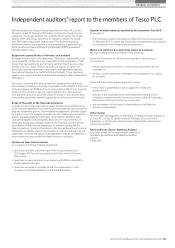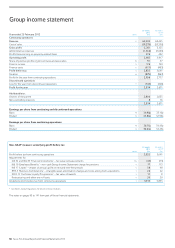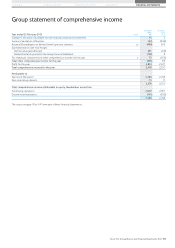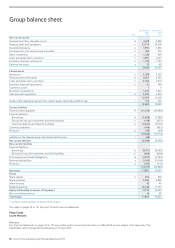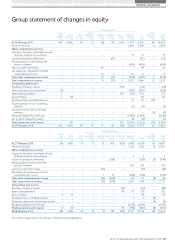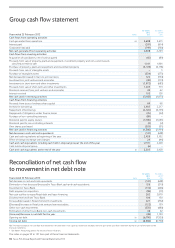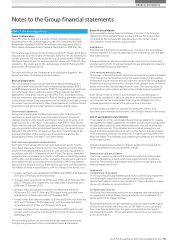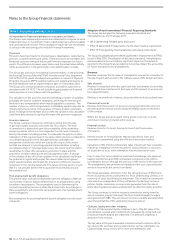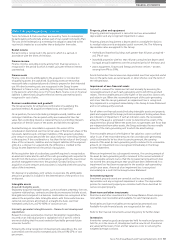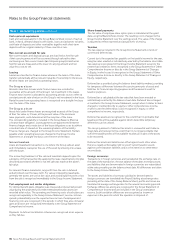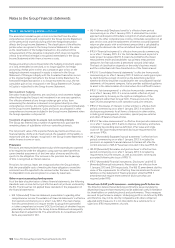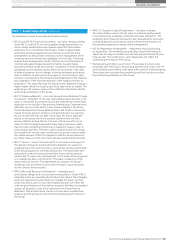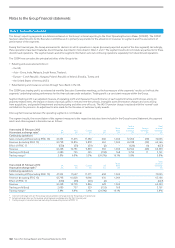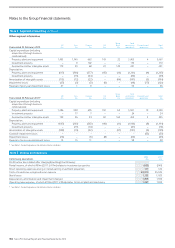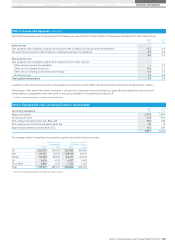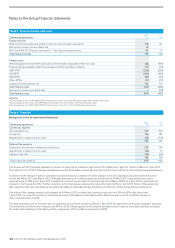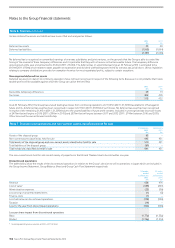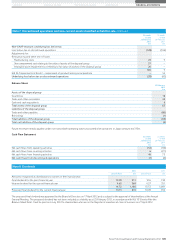Tesco 2012 Annual Report Download - page 103
Download and view the complete annual report
Please find page 103 of the 2012 Tesco annual report below. You can navigate through the pages in the report by either clicking on the pages listed below, or by using the keyword search tool below to find specific information within the annual report.
STRATEGIC REVIEW PERFORMANCE REVIEW GOVERNANCE FINANCIAL STATEMENTS
OVERVIEW
Goodwill and fair value adjustments arising on the acquisition of a foreign
entity are treated as assets and liabilities of the foreign entity and
translated at the closing rate.
Financial instruments
Financial assets and financial liabilities are recognised on the Group
Balance Sheet when the Group becomes a party to the contractual
provisions of the instrument.
Trade receivables
Trade receivables are non interest-bearing and are recognised initially at
fair value, and subsequently at amortised cost using the effective interest
rate method, less provision for impairment.
Investments
Investments are recognised at trade date. Investments are classified as
either held for trading or available-for-sale, and are recognised at fair value.
For available-for-sale investments, gains and losses arising from changes in
fair value are recognised directly in the other comprehensive income, until
the security is disposed of or is determined to be impaired, at which time
the cumulative gain or loss previously recognised in other comprehensive
income is included in the Group Income Statement for the period. Interest
calculated using the effective interest rate method is recognised in the
Group Income Statement. Dividends on an available-for-sale equity
instrument are recognised in the Group Income Statement when the
entity’s right to receive payment is established.
Loans and advances to customers
Loans and advances to customers are not classified as held for trading nor
designated as fair value through profit and loss. Loans and advances are
initially recognised at fair value plus directly related transaction costs.
Subsequent to initial recognition, these assets are carried at amortised cost
using the effective interest method less any impairment losses. Income
from these financial assets is calculated on an effective yield basis and is
recognised in the Group Income Statement.
Impairment of loans and advances to customers
At each balance sheet date the Group reviews the carrying amounts of
its loans and advances to determine whether there is any indication that
those assets have suffered an impairment loss.
If there is objective evidence that an impairment loss on a financial asset
orgroup of financial assets classified as loans and advances has been
incurred, the Group measures the amount of the loss as the difference
between the carrying amount of the asset or group of assets and the
present value of estimated future cash flows from the asset or group of
assets discounted at the effective interest rate of the instrument at initial
recognition. Impairment losses are assessed individually for financial assets
that are individually significant and collectively for assets that are not
individually significant. In making collective assessments of impairment,
financial assets are grouped into portfolios on the basis of similar risk
characteristics. Future cash flows from these portfolios are estimated on
the basis of the contractual cash flows and historical loss experience for
assets with similar credit risk characteristics. Historical loss experience is
adjusted, on the basis of current observable data, to reflect the effects
of current conditions not affecting the period of historical experience.
Impairment losses are recognised in the Group Income Statement and
thecarrying amount of the financial asset or group of financial assets
is reduced by establishing an allowance for impairment losses. If in
a subsequent period the amount of the impairment loss reduces and
the reduction can be ascribed to an event after the impairment was
recognised, the previously recognised loss is reversed by adjusting the
allowance. Once an impairment loss has been recognised on a financial
asset or group of financial assets, interest income is recognised on the
carrying amount using the rate of interest at which estimated future
cash flows were discounted in measuring impairment.
Loan impairment provisions are established on a portfolio basis taking
into account the level of arrears, security, past loss experience, credit scores
and defaults based on portfolio trends. The most significant factors in
establishing these provisions are the expected loss rates. The portfolios
include credit card receivables and other personal advances. The future
credit quality of these portfolios is subject to uncertainties that could cause
actual credit losses to differ materially from reported loan impairment
provisions. These uncertainties include the economic environment, notably
interest rates and their effect on customer spending, the unemployment
level, payment behaviour and bankruptcy trends.
Interest-bearing borrowings
Interest-bearing bank loans and overdrafts are initially recorded at
fair value, net of attributable transaction costs. Subsequent to initial
recognition, interest-bearing borrowings are stated at amortised cost with
any difference between proceeds and redemption value being recognised
in the Group Income Statement over the period of the borrowings on an
effective interest basis.
Trade payables
Trade payables are non interest-bearing and are recognised initially at fair
value and subsequently measured at amortised cost using the effective
interest method.
Equity instruments
Equity instruments issued by the Group are recorded at the proceeds
received, net of direct issue costs.
Derivative financial instruments and hedge accounting
The Group uses derivative financial instruments to hedge its exposure
toforeign exchange, interest rate and commodity risks arising from
operating, financing and investing activities. The Group does not hold
orissue derivative financial instruments for trading purposes, however,
ifderivatives do not qualify for hedge accounting they are accounted for
assuch.
Derivative financial instruments are recognised and stated at fair value.
Where derivatives do not qualify for hedge accounting, any gains or losses
on remeasurement are immediately recognised in the Group Income
Statement. Where derivatives qualify for hedge accounting, recognition of
any resultant gain or loss depends on the nature of the hedge relationship
and the item being hedged. In order to qualify for hedge accounting, the
Group is required to document from inception the relationship between
the item being hedged and the hedging instrument. The Group is also
required to document and demonstrate an assessment of the relationship
between the hedged item and the hedging instrument, which shows that
the hedge will be highly effective on an ongoing basis. This effectiveness
testing is performed at each period end to ensure that the hedge remains
highly effective.
Derivative financial instruments with maturity dates of more than one year
from the balance sheet date are disclosed as non-current.
Fair value hedging
Derivative financial instruments are classified as fair value hedges
when they hedge the Group’s exposure to changes in the fair value of a
recognised asset or liability. Changes in the fair value of derivatives that
aredesignated and qualify as fair value hedges are recorded in the Group
Income Statement together with any changes in the fair value of the
hedged item that is attributable to the hedged risk.
Cash flow hedging
Derivative financial instruments are classified as cash flow hedges when
they hedge the Group’s exposure to variability in cash flows that are either
attributable to a particular risk associated with a recognised asset or
liability, or a highly probable forecasted transaction. The effective element
of any gain or loss from remeasuring the derivative instrument is
recognised directly in the other comprehensive income.
Note 1 Accounting policies continued
Tesco PLC Annual Report and Financial Statements 2012 99


